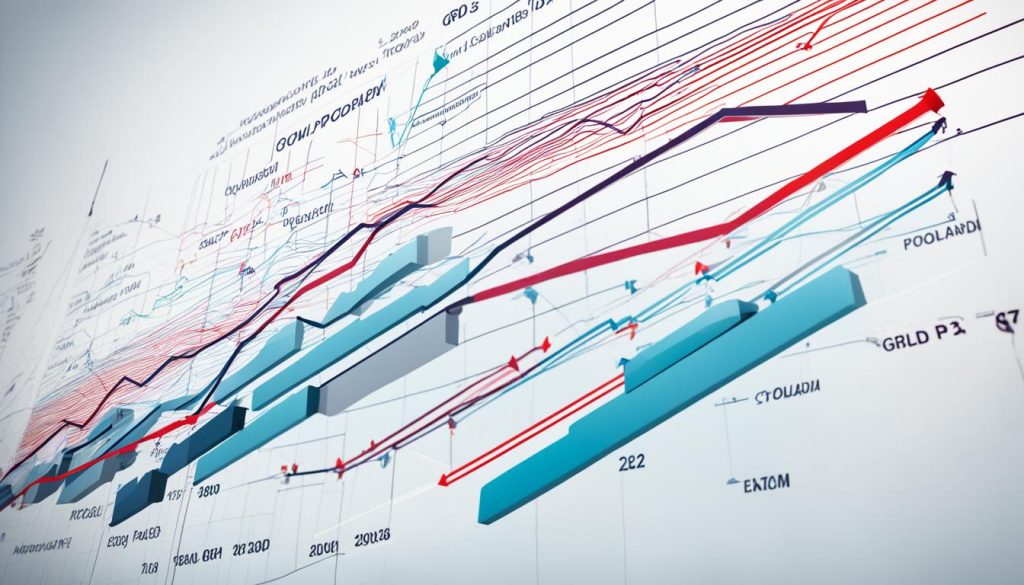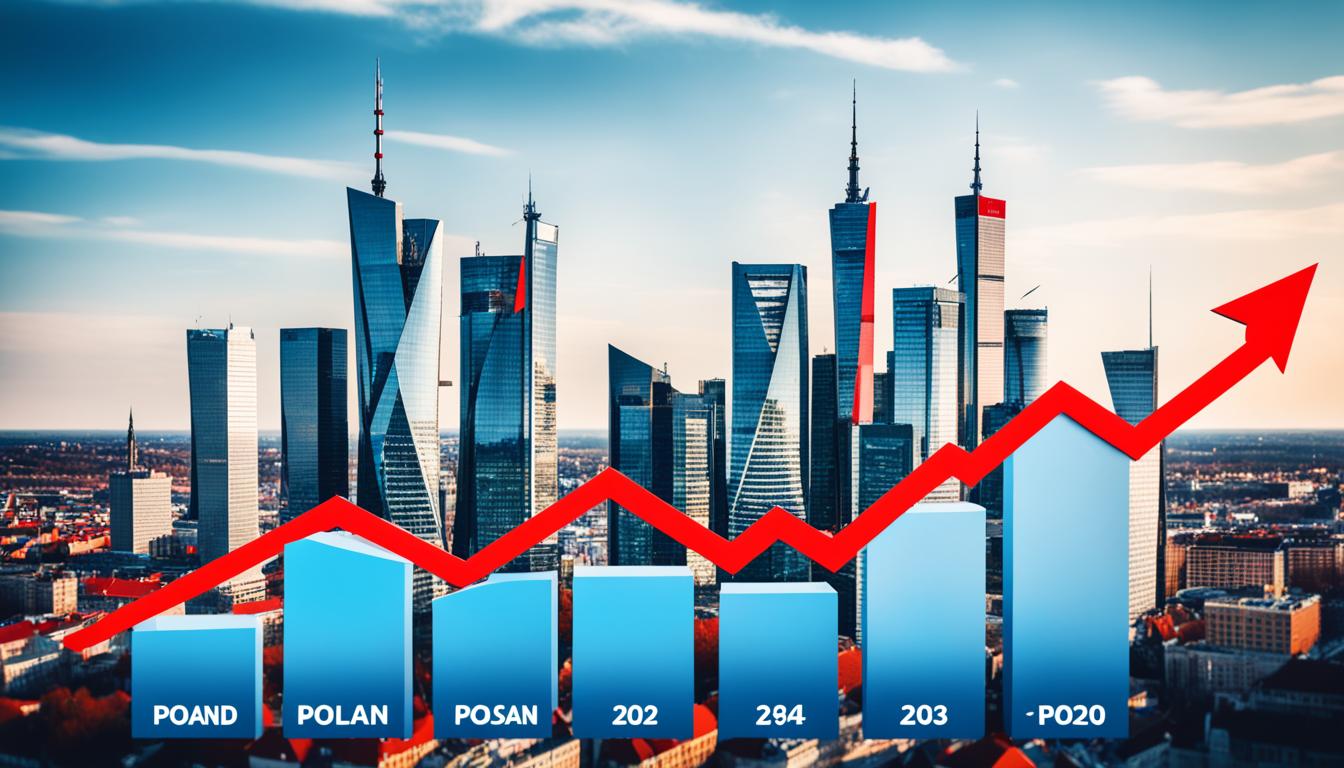GDP growth shines as a beacon of economic performance worldwide. In 2023, Poland’s economic movements are under close watch. Analysts and investors are eager to see where this energetic European economy will go. The financial health of Poland, its regional, and its global impact are all being examined closely.
Diving into Poland’s financial growth takes careful analysis of authoritative data. With insights from the Central Statistical Office of Poland, the IMF, and the World Bank’s latest reports, we get a clearer picture. These sources help us understand the current economic climate and what to expect in the future. They also guide towards strategies for a strong and flexible economy.
Key Takeaways
- Poland’s GDP growth is a paramount indicator of its economic health and future prospects.
- Accurate economic forecasts for Poland in 2023 are grounded in data from the nation’s central statistical authorities and leading financial institutions.
- Recognising the patterns of financial growth in Poland allows for informed investment and policy-making decisions.
- Economic trends in Poland are influenced by both domestic factors and the wider global economic landscape.
- Reliable sources ensure the economic insights provided are current and appropriately contextualised.
- The resilience and adaptability of the 2023 Poland economy are key to its ongoing success.
Overview of Poland’s Economic Performance
An in-depth Poland economic review shows a story of growth and resilience. Looking at past and present data gives us a clear picture of Poland’s economy and its future. This analysis helps us understand the economic situation in Poland, including its challenges and successes in development.
According to Eurostat, Poland’s GDP has seen highs and lows. This reflects global economic trends and the impact of domestic policies. In the context of the European Union, Poland often does better than other countries. This shows its strength and smart policies. Still, unemployment and inflation have seen ups and downs, leading to a deeper look at socio-economic plans and job market conditions.
Technological progress and changes in population present both challenges and opportunities. Innovations increase efficiency but require new skills. Meanwhile, population trends suggest future labour shortages. This means education and immigration policies need to be well-thought-out.
In comparing Poland with other EU countries, the effects of Poland’s trade balance stand out. The Statistical Yearbook of the Republic of Poland shows changes in trade patterns. These changes boost the economy but also create new challenges.
World Economic Forum insights highlight Poland’s strong points. Infrastructure investments and a growing spirit of entrepreneurship are key to its economy. Poland’s economic scene is a mix of various influences, including international trends, regional teamwork, and national policies.
| Economic Indicator | Value | EU Average | Remarks |
|---|---|---|---|
| GDP Growth Rate (Annual) | 4.5% | 2.9% | Higher than the EU average, indicating robust expansion |
| Unemployment Rate | 3.2% | 6.7% | One of the lowest in the EU, signifying strong job market |
| Inflation Rate | 2.2% | 1.7% | Slightly higher, potential pressure point |
| Balance of Trade | +€5 billion | -€15 billion | Positive balance, showing strong export performance |
Poland stands as a model of resilience amid global economic shifts. It showcases careful economic planning and response to big economic pressures. The economic analysis of Poland gives a clear view of the investment scene and government plans for the coming year.
Poland GDP in 2023: A Detailed Analysis
The world’s economy is always changing. It’s crucial to closely examine Poland’s economy. Poland’s GDP growth shows its strong ability to adapt. We will explore how Poland has been growing economically, focusing on key factors that contribute to its economic strength.

An Assessment of GDP Growth
The look at Poland’s GDP for 2023 shows ongoing growth. Predictions from the National Bank of Poland and OECD highlight growth drivers and challenges. This helps us understand Poland’s economic situation within the global economy.
Key Sectors Driving Poland’s Economy
Many sectors are important to Poland’s industrial growth. Studies from the Polish Agency for Enterprise Development and the Ministry of Development Funds show key roles of manufacturing, services, and agriculture. Innovation and foreign investments help these sectors grow, demonstrating Poland’s industrial progress.
Impact of International Trade on GDP
Trade greatly affects Poland’s economy. Analysis by Statistics Poland and the European Commission Trade Policy reveals how. Trade agreements and EU membership have big impacts. Discussing trade’s effect on Poland’s GDP also involves looking at geopolitical changes and the importance of exports and imports.
| Year | Poland GDP Growth Rate | Industrial Sector Growth | Trade Balance |
|---|---|---|---|
| 2021 | 5.9% | – | $-10.24B |
| 2022 | 4.2% | Manufacturing: 4.7% | $-7.38B |
| 2023 (Projected) | 3.6% | Services: 3.5% | $-5.12B (Estimated) |
Government Policies Shaping the Economic Landscape
Poland’s government uses its Poland fiscal policy to drive GDP growth and financial stability. The year 2023 is pivotal. The economy is expected to stabilize and grow. Understanding these strategies, including Poland’s monetary policy, reveals their impact on the nation’s economy.
The government is focusing on supporting the economy, especially during hard times. It’s using tax policy changes to help businesses and investing in infrastructure and education. These steps aim for long-term, sustainable growth.
EU funds are also vital for Poland’s economic strength. They’re used for projects across the country to help with economic recovery and growth. These funds are crucial for targeted development in key areas.
- Fiscal Policy: Tax incentives, public spending
- Economic Reforms: Market liberalization, regulatory adjustments
- Monetary Policy: Interest rate control, financial market oversight
- EU Funds: Leveraging for infrastructure, R&D, and social cohesion
From this viewpoint,
“The strategic alignment of Poland’s fiscal policy, especially in the realm of public investments and tax regulation, has curated an ecosystem conducive to economic dynamism,”
notes the Ministry of Finance in Poland.
| Policy Framework | Objective | Impact Area |
|---|---|---|
| Monetary Stability Measures | Maintain Inflation Control | General Price Levels, Currency Valuation |
| Fiscal Incentives | Stimulate Business Growth | Private Sector Expansion, Job Creation |
| Regulatory Reforms | Enhance Market Efficiency | Investment Appeal, Competitive Standing |
| EU Structural and Investment Funds | Address Regional Disparities | Socio-economic Development, Infrastructure Upgrades |
Poland’s financial future is closely tied to its monetary policy and fiscal approaches. With a focus on adaptive and clear policies, Poland aims to master the economic challenges of 2023 and beyond.
Conclusion
As we wrap up our journey through Poland’s economic landscape in 2023, we see its GDP growth isn’t just a number. It’s a guide showing us its financial health. This increase is key, showing the Poland economic outlook in a vital way. It offers essential insights for investors, companies, and policy-makers.
In the face of both regional and worldwide doubts, Poland stands out. It shows resilience and promise, according to our findings. This makes it an important case of endurance and possibility in economic projections.
Many experts have a cautiously hopeful view on the future of Poland’s economy. Despite some challenges, the country’s main industries show strong potential. This scenario nudges us to keep an eye on how world trends, new technologies, and trade shifts will shape Poland. It underlines the need to watch how the government’s actions might affect the GDP forecast Poland and its stability.
Our talk encourages us to look forward with questions. We are urged to explore Poland’s economic changes, the use of EU funds, and how it adapts to world economic shifts. As Poland moves ahead, its economic story remains a fascinating part of world finance discussions. It deserves more study and focus in the future.
FAQ
What key factors contribute to Poland’s GDP growth?
Poland’s GDP growth is driven by a strong manufacturing sector and more consumer spending. EU funds and steady foreign investment also play a big role. A stable political scene and tech advances in key industries help too.
How reliable are the economic forecasts for Poland?
Economic predictions for Poland come from trusted sources like the IMF and the World Bank. Though global events might cause changes, these forecasts offer solid insights.
In what way does international trade impact Poland’s GDP?
Exports and imports through international trade greatly impact Poland’s GDP. Its EU membership and location aid trade, especially with Germany. Trade deals and global market reach affect its trade balance and GDP.
Which sectors are expected to drive Poland’s economic growth in 2023?
In 2023, sectors like manufacturing, IT services, construction, and farming are set to boost Poland’s economy. These sectors will gain from local investment and strong trade ties.
Are there any concerns regarding Poland’s economic situation?
Concerns about Poland’s economy include global slowdowns and EU politics uncertainties. At home, job market gaps and the need for further reforms pose challenges.
How does the government of Poland plan to sustain economic growth?
Poland’s government plans to keep the economy growing by investing in infrastructure and education. Improving the business landscape and encouraging foreign investment are also key strategies.
Has the COVID-19 pandemic affected Poland’s economic forecast for 2023?
Indeed, COVID-19 has shaped Poland’s economic outlook, with changes depending on current situations. Stimulus efforts by the government aim to lessen the impact, showing in improved GDP forecasts for 2023.
What is the role of the industrial sector in Poland’s economic performance?
The industrial sector is crucial to Poland’s economy, with manufacturing industries exporting various goods. This sector directly raises GDP, creates jobs, and leads to more development in services.
How do demographic shifts in Poland affect its economic trends?
Poland faces challenges like an aging population and people moving abroad. The government and companies must find ways to attract young workers and boost productivity.
What measures are being taken to enhance Poland’s economic resilience?
Poland is improving its economic strength by diversifying its economy and focusing on digital and green energy. Forming stronger trade relationships and using EU development funds are also key to its strategy.



